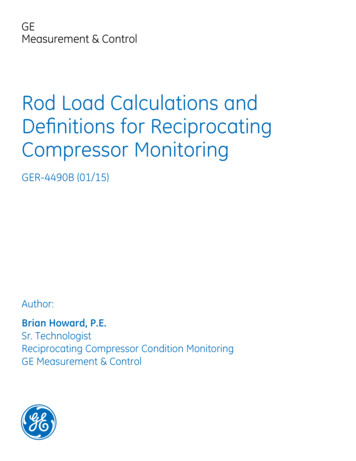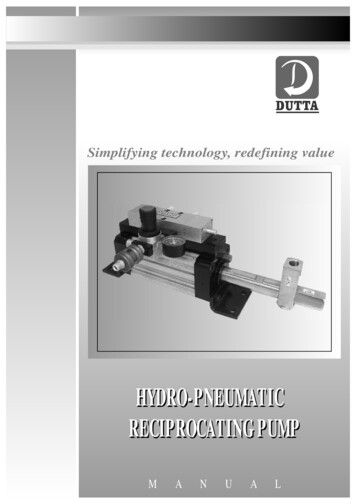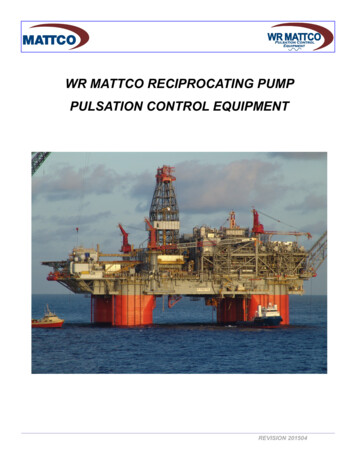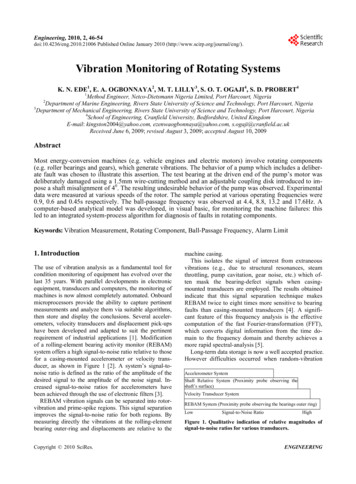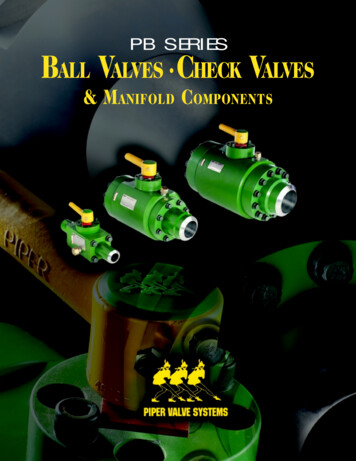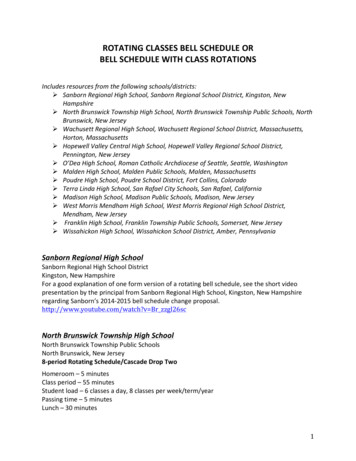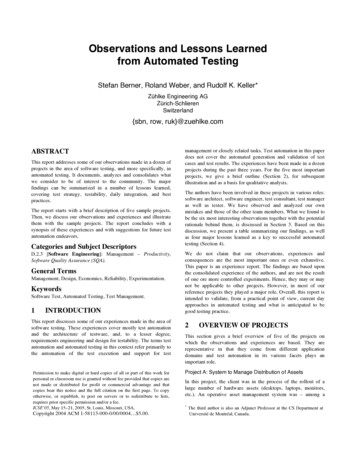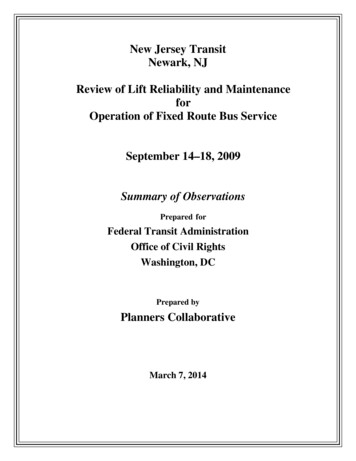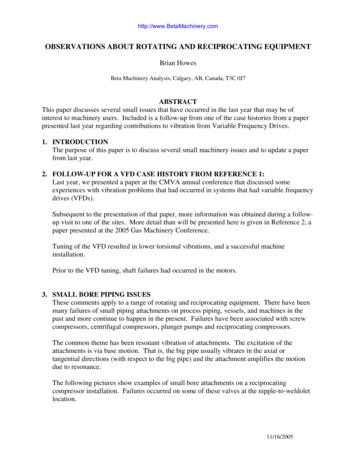
Transcription
http://www.BetaMachinery.comOBSERVATIONS ABOUT ROTATING AND RECIPROCATING EQUIPMENTBrian HowesBeta Machinery Analysis, Calgary, AB, Canada, T3C 0J7ABSTRACTThis paper discusses several small issues that have occurred in the last year that may be ofinterest to machinery users. Included is a follow-up from one of the case histories from a paperpresented last year regarding contributions to vibration from Variable Frequency Drives.1. INTRODUCTIONThe purpose of this paper is to discuss several small machinery issues and to update a paperfrom last year.2. FOLLOW-UP FOR A VFD CASE HISTORY FROM REFERENCE 1:Last year, we presented a paper at the CMVA annual conference that discussed someexperiences with vibration problems that had occurred in systems that had variable frequencydrives (VFDs).Subsequent to the presentation of that paper, more information was obtained during a followup visit to one of the sites. More detail than will be presented here is given in Reference 2, apaper presented at the 2005 Gas Machinery Conference.Tuning of the VFD resulted in lower torsional vibrations, and a successful machineinstallation.Prior to the VFD tuning, shaft failures had occurred in the motors.3. SMALL BORE PIPING ISSUESThese comments apply to a range of rotating and reciprocating equipment. There have beenmany failures of small piping attachments on process piping, vessels, and machines in thepast and more continue to happen in the present. Failures have been associated with screwcompressors, centrifugal compressors, plunger pumps and reciprocating compressors.The common theme has been resonant vibration of attachments. The excitation of theattachments is via base motion. That is, the big pipe usually vibrates in the axial ortangential directions (with respect to the big pipe) and the attachment amplifies the motiondue to resonance.The following pictures show examples of small bore attachments on a reciprocatingcompressor installation. Failures occurred on some of these valves at the nipple-to-weldoletlocation.11/16/2005
http://www.BetaMachinery.comPicture 1 Some small bore attachments.Picture 2 More small bore attachments.11/16/2005
http://www.BetaMachinery.com4. RESONANCEThe definition of resonance is worth reviewing. Resonance is usually explained as occurringwhen a forcing frequency coincides with a natural frequency (NF). It is necessary to definethe degree of coincidence for this definition to be practical. In API 541 Standard, Reference3, resonance is defined as occurring when the forcing frequency is in a frequency range thatextends on either side of the response peak down 6 dB from the maximum amplitude. Wecan quibble over the details, but at least this is a usable definition of resonance.Refer to the graph below. (The data for the graph were calculated for a damped single degreeof freedom spring-mass system.) The graph shows the separation from the natural frequencythat is required to achieve 6dB decrease in amplification either below or above the naturalfrequency. Traditionally, 10 to 15% separation has been used as a rule of thumb forminimum frequency separation form a critical speed or natural frequency. The graphsuggests that this would be sufficient for lightly damped systems, which is how mostmechanical or shaft systems would be defined. The graph seems to describe the separationrequired better as a function of damping.Another way of interpreting the data on the graph, would be to say that it is not necessary tohave 6 dB reduction from the peak response when the system is more heavily damped.Using that reasoning, less frequency separation may be acceptable at higher damping ratios.fraction of NF above or belowthe NFSeparation from Natural Frequency to get 6dBreduction in amplification0.800.700.600.50Below NFAbove NF0.400.300.200.100.000 0.01 0.02 0.03 0.04 0.05 0.06 0.07 0.08 0.09 0.1Damping ratioIn most cases, resonance of an attachment should be avoided with the major sources ofdynamic forces in a machine. For example, with a fixed speed screw compressor with 4pockets, small bore attachments should not have mechanical natural frequencies (MNFs)“near” 1X, 2X, 4X or 8X run speed.11/16/2005
http://www.BetaMachinery.comA demonstration of two frequency ranges to avoid for MNFs of small bore attachments camefrom a centrifugal compressor problem. This problem occurred when a piece of metal gotcaught in the housing of the compressor and resulted in high pressure pulsations in thedischarge piping at shaft rotational frequency and at vane passing frequency. These pressurepulsations caused shaking forces in the piping, which caused vibrations of the piping. Thedrain lines on the discharge line were then subjected to higher “base motion” vibrations thanwere normal. We were contracted to determine if the stresses due to the higher than normalvibrations would be acceptable until the unit could be repaired in a planned shutdown. Thevibrations were worse than they needed to be if the drain attachments had been designed toavoid having MNFs near the frequency range of compressor shaft speed or vane passingfrequency.Plunger pumps can experience the same problem. However, we did see a problem with anattachment (Reference 4) on a pump that was a serious problem (failures occurred) eventhough individual frequencies of vibration were acceptable according to normal industryguidelines. Measurements of overall vibrations in displacement terms showed that thevibrations of the attachments were in fact too high. This is an unusual example whichsuggests that overall true peak differential displacements should be measured on small boreattachments, in general, to determine the safety of systems.On reciprocating compressors, we have seen situations where small bore attachments havehad natural frequencies that were close to the horizontal cylinder natural frequencies(horizontal in the direction of piston motion). The horizontal cylinder stretch motion tendsto be higher at the orders of run speed around this natural frequency of the cylinder. Thishigh motion in turn leads to more energy on the bottles and piping to which small boreattachments append. In other words, there is more energy in the base motion at or near thenatural frequencies of the attachments as a result. Failures have been seen in many instances.The solution in these cases is to change the natural frequencies of the attachments away fromthe natural frequencies of the compressor cylinders (if the small bore attachments cannot beremoved).This course of action (changing NFs) is counter-intuitive for a machine that generatespressure pulsations which are usually the first suspected cause of all vibration problems.5. ADJUSTABLE CHOCKSInstallers of machinery look for easier ways to install, level and align equipment (motors,engines compressors, etc.). Many techniques have been invented. Some methods are moretime consuming and therefore expensive.One system is called Vibracon SM, “The Universal Adjustable Chock”. The goal of thesedevices is to eliminate the need for shims, allow rapid and accurate height adjustment andeliminate soft feet problems.Pictures 3 and 4 show adjustable chocks used successfully under an engine.11/16/2005
http://www.BetaMachinery.comPicture 3 Chock under front of engine.Picture 4 Chock under back of engine.11/16/2005
http://www.BetaMachinery.comWe have seen two situations in which the adjustable washers do not constitute an acceptableconnection between the equipment and the skid. The lateral vibration above the washers, atthe equipment feet, was approximately 50% higher than the vibration just below the washers,at the skid beam where the washers were mounted. If the vibration at the top of the skid ismarginal, or if the installation operates close to resonance, the resulting vibration levels at thecenterline of the machine (compressor or engine) or at the compressor cylinders is not withinour guidelines due, in part, to the amplification across the adjustable washers (chocks).The vibration amplification has been observed at low and at high frequencies. Furtherinvestigation is recommended to understand the limitations of these devices in terms ofequipment type, size, skid design and lateral forces. Many equipment packagers mentionsuccessful installation of these devices under small and medium size motors and underengines. Small reciprocating compressors have also been mounted on adjustable washers,and they, reportedly, show acceptable vibrations.6. TORSIONAL VIBRATION NOTESWe were recently asked to travel to Indonesia to assess some engine-compressor installationsfor both linear and torsional vibrations. Failures had been occurring.The three units were nominally identical from the point of view of torsional vibrations, butnot from the point of view of linear vibrations.Torsional vibration (TV) measurements showed that the torsional natural frequencies (TNFs)were indeed the same on all three units.However, the damping associated with the compressor mode of TV was different from unitto unit. This was exhibited by the fact that the amplitudes of TV at the TNF weresignificantly different on the 3 units, even though they were operating at essentially the sameconditions and load step.As the result of computer models, we recommended a change to the rotational inertia of oneof the compressors, which had the highest measured TV and had experienced an oil pumpfailure.Reports from the field indicated that linear vibrations on the frame of the compressordecreased after the addition of the inertia on the compressor crankshaft. The frequency of thelinear vibrations that have apparently decreased was not the same as the TNF.We expect to collect more vibration data from this unit in the future, which may be moredefinitive.7. STRESSES IN MOTOR ROTORSWe were asked to determine if vibration-induced stresses in a large motor rotor could be highenough to cause concern. We constructed finite element models of the motor rotor with theoriginal design and with the modified design.11/16/2005
http://www.BetaMachinery.comWe were reminded of an interesting observation related to alternating stresses in a rotor thatmay be useful when analyzing vibrations on machines with rotors.If the whirl of the shaft is circular, and at the same frequency as rotation, then the bendingstresses in the rotor are constant with respect to angle of rotation. This means that there areno alternating stresses in the rotor to cause fatigue damage.On the other hand, elliptical whirl shapes and frequency components in the whirl that are notsynchronous with the shaft rotation will cause alternating stresses in a rotor.8. CONCLUSIONSThe world of machinery vibrations is an interesting place.9. REFERENCES1. Howes, B.C., “Perplexing Variable Frequency Drive Vibration Problems,” presented atthe CMVA, Edmonton, AB, 2004.2. De la Roche, L, “Lateral & Torsional Vibration Problems in Systems Equipped withVariable Frequency Drives,” presented at the GMC, Covington, Ky, 2005.3. API 541, Standard of the American Petroleum Institute.4. Howes, Brian C., Berg, Lyle, and Zacharias, Valerie, 1996, “Incorrect Valve Selection onPlunger Pumps Results in Undetected High Frequency Vibration and Costly Failures, ACase Study,” presented at the CMVA, Edmonton, AB.10. AUTHOR BIOGRAPHYBrian graduated from the University of Calgary with a Master of Science in Solid Mechanics.His thesis was entitled Acoustical Pulsations in Reciprocating Compressor Systems.Brian has worked with Beta Machinery Analysis since 1972. In his present position as ChiefEngineer for Beta, he has performed troubleshooting services all over the world.Brian has many technical papers to his credit. The range of machinery problems they coverincludes all manner of reciprocating and rotating machinery and piping systems, balancingand alignment of machines, finite element analysis, modelling of pressure pulsation, torsionalvibration testing and modelling, flow induced pulsation troubleshooting and design, pulp andpaper equipment such as pulp refiners, etc. He has also worked on hundreds of reciprocatingcompressor installations.11/16/2005
OBSERVATIONS ABOUT ROTATING AND RECIPROCATING EQUIPMENT Brian Howes Beta Machinery Analysis, Calgary, AB, Canada, T3C 0J7 ABSTRACT This paper discusses several small issues that have occurred in the last year that may be of interest to machinery users. Included is a follow-up from one of the case histories from a paper presented last year regarding contributions to vibration
